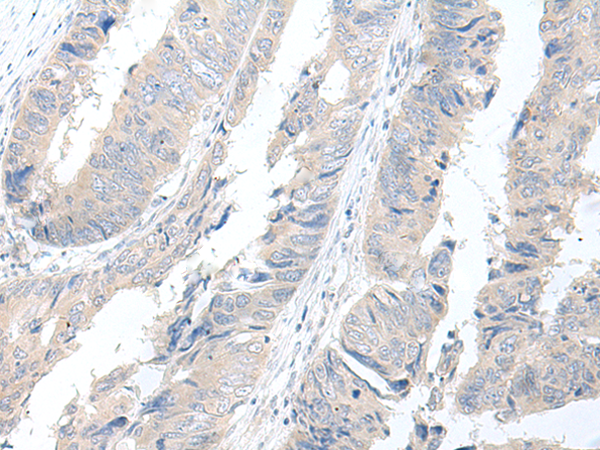
| WB | 咨询技术 | Human,Mouse,Rat |
| IF | 咨询技术 | Human,Mouse,Rat |
| IHC | 1/50-1/300 | Human,Mouse,Rat |
| ICC | 技术咨询 | Human,Mouse,Rat |
| FCM | 咨询技术 | Human,Mouse,Rat |
| Elisa | 1/5000-1/10000 | Human,Mouse,Rat |
| Aliases | AD035; SPG46; NLGase |
| Host/Isotype | Rabbit IgG |
| Antibody Type | Primary antibody |
| Storage | Store at 4°C short term. Aliquot and store at -20°C long term. Avoid freeze/thaw cycles. |
| Species Reactivity | Human, Mouse, Rat |
| Immunogen | Fusion protein of human GBA2 |
| Formulation | Purified antibody in PBS with 0.05% sodium azide and 50% glycerol. |
+ +
以下是关于GBA2抗体的3篇参考文献及其摘要概括:
---
1. **文献名称**: *Generation of a specific polyclonal antibody against human brain neutral β-glucosidase (GBA2) by peptide immunization in Yucatan mini-pigs*
**作者**: Yildiz Y, Matern H, Thompson B, et al.
**摘要**: 该研究描述了通过多肽免疫尤卡坦小型猪制备针对人脑GBA2酶的多克隆抗体,验证了其特异性,并用于检测GBA2在细胞和组织中的表达及酶活性抑制实验。
2. **文献名称**: *GBA2 activity in the nervous system and its relationship to hereditary spastic paraplegia*
**作者**: Dekker N, Voorn-Brouwer T, Verhoek M, et al.
**摘要**: 研究通过免疫印迹和免疫组化技术,利用GBA2抗体分析其在神经组织中的分布,发现GBA2活性缺失与遗传性痉挛性截瘫(SPG46)相关,提示其在轴突脂代谢中的关键作用。
3. **文献名称**: *GBA2/β-glucosidase 2 is a key mediator of lipid metabolism and cellular homeostasis*
**作者**: Hsu TR, Lee CL, Cheng LH, et al.
**摘要**: 文章通过Western blot和免疫荧光技术,证明GBA2抗体可特异性识别小鼠肝脏和脑组织中的蛋白表达,揭示其在鞘脂代谢及细胞能量稳态调控中的生理功能。
---
以上文献均涉及GBA2抗体的开发或应用,涵盖疾病机制、酶功能及代谢调控研究。如需更详细内容,建议通过PubMed或期刊数据库查询全文。
The GBA2 antibody targets the enzyme glucosylceramidase beta 2 (GBA2), a membrane-associated protein encoded by the GBA2 gene. Unlike its paralog GBA1. which is a lysosomal enzyme linked to Gaucher disease, GBA2 is a non-lysosomal glucosylceramidase localized to the endoplasmic reticulum and cell membrane. It plays a role in glycolipid metabolism by hydrolyzing glucosylceramide to glucose and ceramide, influencing cellular processes like membrane dynamics and signaling.
GBA2 gained attention due to its association with hereditary spastic paraplegia (HSP) and cerebellar ataxia. Mutations in the GBA2 gene are implicated in neurodegenerative disorders, highlighting its importance in maintaining neuronal health. Research also suggests potential links to other conditions, including multiple sclerosis and cancer, though mechanisms remain under investigation.
Antibodies against GBA2 are critical tools for studying its expression, localization, and function. They enable detection via Western blotting, immunohistochemistry, and immunofluorescence, aiding in disease-related research and biomarker discovery. Commercial GBA2 antibodies are typically validated for specificity across human and murine samples, though variability in isoform detection requires careful experimental design.
Current challenges include understanding GBA2's precise physiological roles and reconciling conflicting findings across studies. The development of high-affinity, well-characterized GBA2 antibodies remains essential for advancing translational research in neurology and oncology.
×